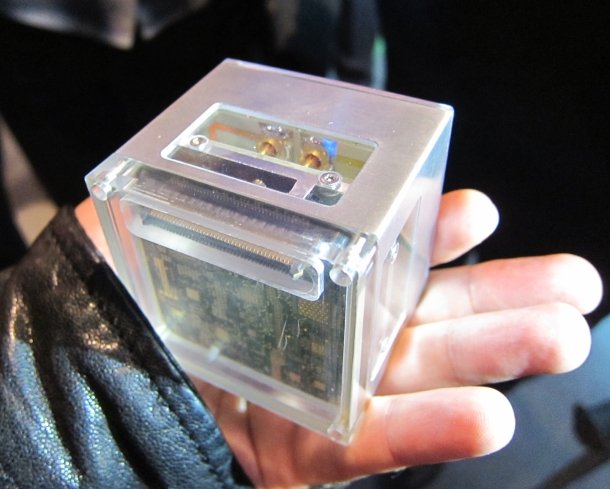Alcatel-Lucent launches LightRadio base station rival

Alcatel-Lucent, HP and Freescale have unveiled a new mobile communications technology called LightRadio, which the companies say could supersede the traditional cellular base station.
LightRadio, announced on Monday, is being pitched as a cheaper and greener alternative to current base station technology. It separates the radio and processing components of a base station so that small, light units can be installed on telephone poles and the sides of houses, rather than requiring masts with large cabinets.

Alcatel-Lucent and its partners have unveiled LightRadio mobile communications technology, which is housed in a small cube. Photo credit: David Meyer
Alcatel-Lucent's research arm, Bell Labs, has shrunk the radio components — diplexer, radio, amplifier and passive cooling — and put them into a small cube, weighing about 300g, which can be connected to a fibre network.
The processing components are shrunk onto a Freescale system-on-a-chip (SoC) that can be placed alongside the radio cube on the mast or elsewhere — an approach that allows for easier maintenance as it requires less on-site upkeep. HP is collaborating with Alcatel-Lucent on the virtualised processing platform that will control the load.
Wim Sweldens, the president of Alcatel-Lucent's Wireless Division, said at the launch in London that the LightRadio cube can be used for 2G, 3G or 4G transmission as needed.
"At the click of a button, it can address any frequency used by any operator in the world," Sweldens said, adding that the device was capable of dynamically adapting the radio signal and radio power to address demand in real time. "This cube is a fully functional unit — you just need to connect it and you have replaced all these technologies."
Javier Garcia Gomez, who headed up the Bell Labs team that came up with LightRadio, said at the launch that around 20 LightRadio cubes — the devices can be stacked — would be needed to replace the average 3G base station, although this number can vary dramatically according to the use case.
Mobile network costs
Sweldens claimed that, over three years, LightRadio would be able to cut the total cost of owning and operating a mobile network by more than 50 percent. He also said LightRadio infrastructure would use half the energy of current infrastructure — Bell Labs estimates that base stations are responsible for 18 million metric tons of CO2 emissions a year.
The wideband active array antenna element of the LightRadio technology will be trialled later this year and become available for commercial deployment in 2012, Sweldens said, noting that operators would be able to "mix and match" LightRadio technology with traditional base station kit. Orange, Verizon, China Mobile and two other as-yet-unidentified operators have signed up for trials, he said.
The other parts of the system — the multi-band remote radio head, baseband unit, controller and 5620 SAM 'common management solution' — will be made available over 2012, 2013 and 2014.
LightRadio will be publicly demonstrated for the first time at the Mobile World Congress in Barcelona next week, Sweldens added, noting that Alcatel-Lucent and its partners would introduce new capabilities and "elements of the LightRadio family" on a strict six-monthly schedule. He said this timing represented "the right rhythm" to match operators' upgrade cycles.
Get the latest technology news and analysis, blogs and reviews delivered directly to your inbox with ZDNet UK's newsletters.